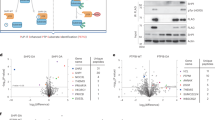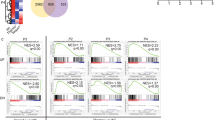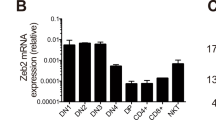Abstract
THEMIS, a T cell–specific protein with high expression in CD4+CD8+ thymocytes, has a crucial role in positive selection and T cell development. THEMIS lacks defined catalytic domains but contains two tandem repeats of a distinctive module of unknown function (CABIT). Here we found that THEMIS directly regulated the catalytic activity of the tyrosine phosphatase SHP-1. This action was mediated by the CABIT modules, which bound to the phosphatase domain of SHP-1 and promoted or stabilized oxidation of SHP-1's catalytic cysteine residue, which inhibited the tyrosine-phosphatase activity of SHP-1. Deletion of SHP-1 alleviated the developmental block in Themis−/− thymocytes. Thus, THEMIS facilitates thymocyte positive selection by enhancing the T cell antigen receptor signaling response to low-affinity ligands.
This is a preview of subscription content, access via your institution
Access options
Access Nature and 54 other Nature Portfolio journals
Get Nature+, our best-value online-access subscription
$29.99 / 30 days
cancel any time
Subscribe to this journal
Receive 12 print issues and online access
$209.00 per year
only $17.42 per issue
Buy this article
- Purchase on Springer Link
- Instant access to full article PDF
Prices may be subject to local taxes which are calculated during checkout







Similar content being viewed by others
Change history
07 March 2017
In the version of this article initially published online, in the second sentence of the first paragraph of the third subsection of Results ('Deletion of Ptpn6 restores T cell development in Themis–/– mice'), the TCR chain is identified incorrectly as 'CD3'; that phrase should read "...antibody to the TCR invariant chain CD3ε (anti-CD3ε)..." instead. In the legend to Figure 3, the P value (< 0.005) was incorrect; the correct value is P < 0.05. Also, in the final sentence of that legend, the directions '(left)' and '(right)' are incorrect; that should read "Data are representative of (top) or from (bottom) four experiments..." instead. In Figure 4a, the numbers along the horizontal axes are incorrectly vertical; they should be horizontal instead. In Figure 4b, the labels along the vertical axes of the second and fourth plots incorrectly include '(%)'; the correct label is 'CD8SP cells (×106)' only. In the third sentence of the first paragraph of the fifth subsection of Results ('p-SHP-1 does not correspond with PTP activity'), the word 'of' is missing; this should read "The lower abundance of p-SHP-1..." instead. In the legend to Figure 5c, the antibody is incorrectly set off in commas; that should read "...immunoprecipitated with anti-SHP-1 from..." instead. Finally, Figure 7e is too large and should be the same size as all other panels in that figure. The errors have been corrected in the print, PDF and HTML versions of this article.
References
Koch, U. & Radtke, F. Mechanisms of T cell development and transformation. Annu. Rev. Cell Dev. Biol. 27, 539–562 (2011).
Aifantis, I., Mandal, M., Sawai, K., Ferrando, A. & Vilimas, T. Regulation of T-cell progenitor survival and cell-cycle entry by the pre-T-cell receptor. Immunol. Rev. 209, 159–169 (2006).
Starr, T.K., Jameson, S.C. & Hogquist, K.A. Positive and negative selection of T cells. Annu. Rev. Immunol. 21, 139–176 (2003).
Hogquist, K.A. & Jameson, S.C. The self-obsession of T cells: how TCR signaling thresholds affect fate 'decisions' and effector function. Nat. Immunol. 15, 815–823 (2014).
Brownlie, R.J. & Zamoyska, R. T cell receptor signalling networks: branched, diversified and bounded. Nat. Rev. Immunol. 13, 257–269 (2013).
Pao, L.I., Badour, K., Siminovitch, K.A. & Neel, B.G. Nonreceptor protein-tyrosine phosphatases in immune cell signaling. Annu. Rev. Immunol. 25, 473–523 (2007).
Lesourne, R. et al. Themis, a T cell-specific protein important for late thymocyte development. Nat. Immunol. 10, 840–847 (2009).
Fu, G. et al. Themis controls thymocyte selection through regulation of T cell antigen receptor-mediated signaling. Nat. Immunol. 10, 848–856 (2009).
Johnson, A.L. et al. Themis is a member of a new metazoan gene family and is required for the completion of thymocyte positive selection. Nat. Immunol. 10, 831–839 (2009).
Kakugawa, K. et al. A novel gene essential for the development of single positive thymocytes. Mol. Cell. Biol. 29, 5128–5135 (2009).
Patrick, M.S. et al. Gasp, a Grb2-associating protein, is critical for positive selection of thymocytes. Proc. Natl. Acad. Sci. USA 106, 16345–16350 (2009).
Paster, W. et al. GRB2-mediated recruitment of THEMIS to LAT is essential for thymocyte development. J. Immunol. 190, 3749–3756 (2013).
Lesourne, R. et al. Interchangeability of Themis1 and Themis2 in thymocyte development reveals two related proteins with conserved molecular function. J. Immunol. 189, 1154–1161 (2012).
Zvezdova, E. et al. Themis1 enhances T cell receptor signaling during thymocyte development by promoting Vav1 activity and Grb2 stability. Sci. Signal. 9, ra51 (2016).
Paster, W. et al. A THEMIS:SHP1 complex promotes T-cell survival. EMBO J. 34, 393–409 (2015).
Fu, G. et al. Themis sets the signal threshold for positive and negative selection in T-cell development. Nature 504, 441–445 (2013).
Gascoigne, N.R. & Acuto, O. THEMIS: a critical TCR signal regulator for ligand discrimination. Curr. Opin. Immunol. 33, 86–92 (2015).
Okada, T. et al. Differential function of Themis CABIT domains during T cell development. PLoS One 9, e89115 (2014).
Davey, G.M. et al. Preselection thymocytes are more sensitive to T cell receptor stimulation than mature T cells. J. Exp. Med. 188, 1867–1874 (1998).
Zvezdova, E. et al. In vivo functional mapping of the conserved protein domains within murine Themis1. Immunol. Cell Biol. 92, 721–728 (2014).
Cibotti, R., Punt, J.A., Dash, K.S., Sharrow, S.O. & Singer, A. Surface molecules that drive T cell development in vitro in the absence of thymic epithelium and in the absence of lineage-specific signals. Immunity 6, 245–255 (1997).
Pathak, M.K. & Yi, T. Sodium stibogluconate is a potent inhibitor of protein tyrosine phosphatases and augments cytokine responses in hemopoietic cell lines. J. Immunol. 167, 3391–3397 (2001).
Lee, P.P. et al. A critical role for Dnmt1 and DNA methylation in T cell development, function, and survival. Immunity 15, 763–774 (2001).
Huyer, G. et al. Mechanism of inhibition of protein-tyrosine phosphatases by vanadate and pervanadate. J. Biol. Chem. 272, 843–851 (1997).
Karisch, R. & Neel, B.G. Methods to monitor classical protein-tyrosine phosphatase oxidation. FEBS J. 280, 459–475 (2013).
Michalek, R.D. et al. The requirement of reversible cysteine sulfenic acid formation for T cell activation and function. J. Immunol. 179, 6456–6467 (2007).
Singh, D.K. et al. The strength of receptor signaling is centrally controlled through a cooperative loop between Ca2+ and an oxidant signal. Cell 121, 281–293 (2005).
Capasso, M. et al. HVCN1 modulates BCR signal strength via regulation of BCR-dependent generation of reactive oxygen species. Nat. Immunol. 11, 265–272 (2010).
Lorenz, U. SHP-1 and SHP-2 in T cells: two phosphatases functioning at many levels. Immunol. Rev. 228, 342–359 (2009).
Ozawa, T., Nakata, K., Mizuno, K. & Yakura, H. Negative autoregulation of Src homology region 2-domain-containing phosphatase-1 in rat basophilic leukemia-2H3 cells. Int. Immunol. 19, 1049–1061 (2007).
Devadas, S., Zaritskaya, L., Rhee, S.G., Oberley, L. & Williams, M.S. Discrete generation of superoxide and hydrogen peroxide by T cell receptor stimulation: selective regulation of mitogen-activated protein kinase activation and fas ligand expression. J. Exp. Med. 195, 59–70 (2002).
Los, M. et al. IL-2 gene expression and NF-κB activation through CD28 requires reactive oxygen production by 5-lipoxygenase. EMBO J. 14, 3731–3740 (1995).
Jackson, S.H., Devadas, S., Kwon, J., Pinto, L.A. & Williams, M.S. T cells express a phagocyte-type NADPH oxidase that is activated after T cell receptor stimulation. Nat. Immunol. 5, 818–827 (2004).
Pani, G., Colavitti, R., Borrello, S. & Galeotti, T. Endogenous oxygen radicals modulate protein tyrosine phosphorylation and JNK-1 activation in lectin-stimulated thymocytes. Biochem. J. 347, 173–181 (2000).
Plas, D.R. et al. Direct regulation of ZAP-70 by SHP-1 in T cell antigen receptor signaling. Science 272, 1173–1176 (1996).
Halliwell, B. Cell culture, oxidative stress, and antioxidants: avoiding pitfalls. Biomed. J. 37, 99–105 (2014).
Stefanova, I. et al. TCR ligand discrimination is enforced by competing ERK positive and SHP-1 negative feedback pathways. Nat. Immunol. 4, 248–254 (2003).
Andersen, J.N. et al. Structural and evolutionary relationships among protein tyrosine phosphatase domains. Mol. Cell. Biol. 21, 7117–7136 (2001).
Tanner, J.J., Parsons, Z.D., Cummings, A.H., Zhou, H. & Gates, K.S. Redox regulation of protein tyrosine phosphatases: structural and chemical aspects. Antioxid. Redox Signal. 15, 77–97 (2011).
Pregel, M.J. & Storer, A.C. Active site titration of the tyrosine phosphatases SHP-1 and PTP1B using aromatic disulfides. Reaction with the essential cysteine residue in the active site. J. Biol. Chem. 272, 23552–23558 (1997).
Chen, C.Y., Willard, D. & Rudolph, J. Redox regulation of SH2-domain-containing protein tyrosine phosphatases by two backdoor cysteines. Biochemistry 48, 1399–1409 (2009).
Smith-Garvin, J.E., Koretzky, G.A. & Jordan, M.S. T cell activation. Annu. Rev. Immunol. 27, 591–619 (2009).
Bunda, S. et al. Inhibition of SHP2-mediated dephosphorylation of Ras suppresses oncogenesis. Nat. Commun. 6, 8859 (2015).
Fang, X. et al. Shp2 activates Fyn and Ras to regulate RBL-2H3 mast cell activation following FcepsilonRI aggregation. PLoS One 7, e40566 (2012).
Moon, E.Y., Han, Y.H., Lee, D.S., Han, Y.M. & Yu, D.Y. Reactive oxygen species induced by the deletion of peroxiredoxin II (PrxII) increases the number of thymocytes resulting in the enlargement of PrxII-null thymus. Eur. J. Immunol. 34, 2119–2128 (2004).
Jin, R. et al. Trx1/TrxR1 system regulates post-selected DP thymocytes survival by modulating ASK1-JNK/p38 MAPK activities. Immunol. Cell Biol. 93, 744–752 (2015).
Simeoni, L. & Bogeski, I. Redox regulation of T-cell receptor signaling. Biol. Chem. 396, 555–568 (2015).
Pao, L.I. et al. B cell-specific deletion of protein-tyrosine phosphatase Shp1 promotes B-1a cell development and causes systemic autoimmunity. Immunity 27, 35–48 (2007).
Jang, I.K. et al. Grb2 functions at the top of the T-cell antigen receptor-induced tyrosine kinase cascade to control thymic selection. Proc. Natl. Acad. Sci. USA 107, 10620–10625 (2010).
Acknowledgements
We thank M. Muschen (University of California, San Francisco) for Ptpn6flox/flox mice; H. Gu (McGill University) for Grb2fl/fl mice; A. Ullrich (Max-Plank Institute, Germany) for Ptpn6 cDNA; L. Tautz (Sanford-Burnham Medical Research Institute) for Ptpn7 cDNA; J. Chernoff (Fox Chase Cancer Center) for plasmid encoding hemagglutinin-tagged PTPN1; and A. Bhandoola, R. Bosselut, R. Cornall, K. Pfeifer and A. Singer for critical review of the manuscript. Supported by the Intramural Research Program of the Eunice Kennedy Shriver National Institute of Child Health and Human Development (1ZIAHD001803 to P.E.L.) and by the Intramural Research Program of the National Library of Medicine (L.A.).
Author information
Authors and Affiliations
Contributions
S.C., C.W., E.Z., J.L. and J.A. performed the experiments; S.C., R.L. and P.E.L. were responsible for the concept and experimental design; L.A. performed proteomics, protein modeling and evolutionary analysis for the CABIT module and CABIT proteins; and P.E.L. wrote the manuscript.
Corresponding author
Ethics declarations
Competing interests
The authors declare no competing financial interests.
Integrated supplementary information
Supplementary Figure 1 THEMIS selectively binds to SHP-1 and SHP-2.
a, THEMIS binds to SHP-1 but not PTPN1 or PTPN7. HEK-293 cells were transfected with plasmids encoding Flag-tagged THEMIS plus plasmids encoding SHP-1 (left), PTPN7 (middle) or PTPN1 (right). Cell lysates of transfected cells were analyzed directly by SDS-PAGE and immunoblotting (lower blots) or incubated with anti-Flag and immunoprecipitated proteins were subjected to SDS-PAGE then immunoblotted with the indicated antibodies (upper blots). One representative of two experiments. b, THEMIS binds to SHP-2. HEK-293 cells were transfected with plasmids encoding GST or GST-THEMIS. Lower blot is endogenous SHP-2. Upper blots show GST or GST-THEMIS pull downs blotted with anti-SHP-2 or anti-GST. One representative of two experiments. c,d,THEMIS CABIT modules bind to the SHP-1 PTP domain. Purified His-tagged CABIT-1 (THEMIS-1-260) or CABIT-2 (THEMIS-260-493) and GST-ΔSH2-SHP-1 proteins were incubated in GST binding buffer then incubated with glutathione beads. Bound proteins were subjected to SDS-PAGE and then blotted with anti-His. e, THEMIS-C-A binds SHP-1. CABIT-1 and CABIT-2 core domain cysteine residues were mutated to alanine (C-A). Plasmids encoding THEMIS, THEMIS-C-A and SHP-1 were transfected into HEK-293 cells in the combinations indicated. Flag (THEMIS) immunoprecipitated proteins (upper blot) or cell lysates (lower blot) were blotted for SHP-1. One representative of two experiments.
Supplementary Figure 2 Deletion of Ptpn6 ‘rescues’ T cell development in Themis-/- mice.
a, Flow cytometry analysis of thymocytes (left) or splenocytes (right) from mice of the indicated genotype. Thymus: two parameter plots show CD4 versus CD8 staining of total thymocytes or gated TCRhi thymocytes. Spleen: two parameter plots show CD4 versus CD8 staining of total spleen cells or CD62L versus CD44 staining of gated CD4 SP cells. Percentage of cells in the indicated quadrants are shown. b, Expression of THEMIS and SHP-1 in total thymocytes from the experiment shown. c, CD4 SP and CD8 SP T cell counts (x106) from thymus and spleen of the indicated mice (see a). Data shown are representative of 3 independent experiments. Error bars are SD, t-test 2-tailed, equal variance. *P<.05, **P<.01, ***P<.005. n.s., not significant (P >.05).
Supplementary Figure 3 THEMIS promotes or stabilizes active-site oxidation of SHP-1.
a, SHP-1 oxidation by pervanadate (PV) in vitro. Repeat of experiment shown in Fig. 5a. b, SHP-1 oxidation by PV in transfected HEK293 cells. Repeat of experiment shown in Fig. 5b. c, SHP-1 is rapidly oxidized in thymocytes lysed in buffer lacking PTP inhibitors. Lanes 1-3, thymocytes from the indicated mice were lysed on ice in degassed oxidation lysis buffer containing IAP-Bio to immediately label reduced PTP active site cysteines. Lanes 4-6, thymocytes were lysed on ice for 20 min in lysis buffer without PTP inhibitors then IAP-Bio was added. All lysates were incubated for 1 hr with anti-SHP-1 and immunoprecipitated proteins were analyzed by immunoblotting with Streptavidin (SA)-HRP to detect biotinylated protein. d, PTP activity of SHP-1 immunoprecipitated from thymocyte cell lysates. Cells were lysed in degassed PTP lysis buffer without PTP inhibitors for 20 min on ice, anti-SHP-1 was added and lysates were rotated for 1 h at 4°C. Immunoprecipitated SHP-1 was assayed for PTP activity as described in methods. e, SHP-1 oxidation in vivo. Repeat of experiment shown in Fig. 5d.
Supplementary Figure 4 Themis−/− signaling defects are revealed in the presence of ROS.
a, TCR stimulation does not induce ROS production in thymocytes. Freshly harvested thymocytes from B6 mice were unstimulated or stimulated for 5 min with anti-CD3+CD4, anti-CD3+CD28 or phorbol 12-myristate 13-acetate (PMA), lysed, and Reactive Oxygen Species (ROS) were measured by chemiluminescence assay. Results are from three experiments. b, Reduced induction of p-ZAP-70 in peptide stimulated Themis−/− thymocytes. Purified CD4+CD8+ thymocytes from MHCII (I-A)−/− mice expressing the OTII-TCR were rested for three hours at 5x106 cells/ml in RPMI at 37°C prior stimulation. Purified splenic B cells were pulsed for 2h at 37°C with 100ng/ml of OVA peptide (ISQAVHAAHAEINEAGR) or no peptide (NP) in RPMI supplemented with 5% FBS and 10mM HEPES. For stimulation, pulsed B cells and thymocytes were mixed at a ratio of 1/10 and spun at 5000 x g prior incubation at 37°C for the indicated time. Cells were lysed in Standard lysis buffer then subjected to SDS-PAGE and immunoblotted with the indicated antibodies. Data shown are representative of 2 independent experiments.
Supplementary Figure 5 Inhibition of SHP-1 by THEMIS is attenuated by the ROS scavenger N-acetyl-l-cysteine (NAC).
a, THEMIS-mediated inhibition of SHP-1 is attenuated by NAC in transfected HEK-293 cells. HEK-293 cells were transfected with plasmid encoding the protein tyrosine kinase SYK, a target of SHP-1, plus or minus plasmids encoding SHP-1 and THEMIS. Transfected cells were treated or not overnight with N-acetyl-cysteine (NAC) before lysis, SDS-PAGE and western blotting with the indicated antibodies. One representative of 2 experiments. b, THEMIS-mediated inhibition of SHP-1 in vitro is partially attenuated in the presence of NAC. SHP-1 was assayed for PTP activity in the presence or absence of THEMIS and NAC as indicated. PTP assay was performed as is described in Methods. Bar graphs show means +/- SD, t-test, two-tailed, equal variance. n=3 each. ***P<.005, ****P<.001.
Supplementary information
Supplementary Text and Figures
Supplementary Figures 1–5 (PDF 849 kb)
Rights and permissions
About this article
Cite this article
Choi, S., Warzecha, C., Zvezdova, E. et al. THEMIS enhances TCR signaling and enables positive selection by selective inhibition of the phosphatase SHP-1. Nat Immunol 18, 433–441 (2017). https://doi.org/10.1038/ni.3692
Received:
Accepted:
Published:
Issue Date:
DOI: https://doi.org/10.1038/ni.3692
This article is cited by
-
THEMIS is a substrate and allosteric activator of SHP1, playing dual roles during T cell development
Nature Structural & Molecular Biology (2024)
-
Positive regulation of Vav1 by Themis controls CD4 T cell pathogenicity in a mouse model of central nervous system inflammation
Cellular and Molecular Life Sciences (2024)
-
Themis suppresses the effector function of CD8+ T cells in acute viral infection
Cellular & Molecular Immunology (2023)
-
Thymocyte regulatory variant alters transcription factor binding and protects from type 1 diabetes in infants
Scientific Reports (2022)
-
Themis regulates metabolic signaling and effector functions in CD4+ T cells by controlling NFAT nuclear translocation
Cellular & Molecular Immunology (2021)



